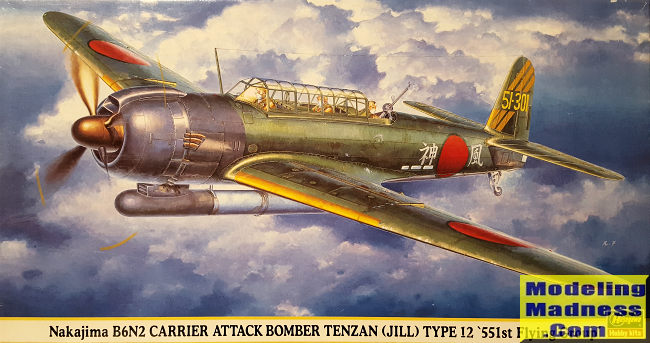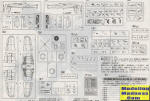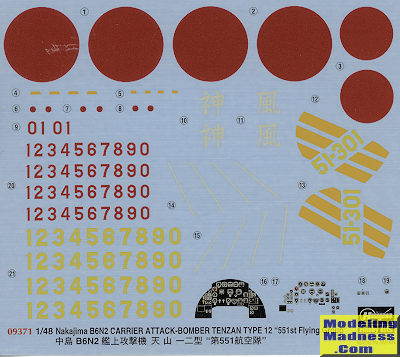
Hasegawa 1/48 B6N2 Tenzan '551st Flying Group'
| KIT #: | 09371 |
| PRICE: | $15.00 'used' |
| DECALS: | one option |
| REVIEWER: | Scott Van Aken |
| NOTES: | 2001 Limited Edition |

| HISTORY |
The B6N Tenzan began reaching front-line units in August 1943 in small numbers. The intent was to gradually replace all of the B5N Kate torpedo bombers then operating aboard the carriers of the Third Fleet at Truk Atoll in the Caroline Islands. However, the B6Ns were prematurely committed to battle when increased Allied naval activity in the Solomon Islands indicated a likely invasion at Bougainville. In response to this threat, the IJN initiated Operation Ro. This involved reinforcing land-based air units at Rabaul with 173 carrier aircraft from First Carrier Division (Zuikaku, Shokaku and Zuiho), including forty B6Ns. These aircraft were flown from Truk to Rabaul between 28 October and 1 November.
On 5 November fourteen B6N1s, escorted by four A6M Zero fighters, were sent to attack American shipping anchored off Bougainville. Four B6N1s were lost and no hits were scored, returning Japanese pilots claimed to have sunk one large and one medium carrier, two heavy cruisers and two other cruisers or large destroyers.
Additional attacks on 8 November and 11 November, suffered heavy losses, with only 52 of the original 173 planes from the First Carrier Division making it back to Truk on 13 November, among them, just six B6N1 Tenzan's out of the forty committed. On 19 June 1944, the B6N made its carrier-borne combat debut at The Battle of the Philippine Sea, operating in an environment where the U.S. Navy had virtually complete air superiority. Subsequently, it failed to inflict any damage whilst taking heavy losses from the U.S. Navy's new F6F Hellcat fighter.
By this point, small improvements in the B6N's performance were amongst the least of the Japanese Navy's problems. When the new model became available in mid-1944, Japan had already lost most of its large carriers and became desperately short of experienced pilots. Therefore, the vast majority of B6N2 operations took place from land bases and failed to achieve any major successes. The planes were extensively used in the Battle of Okinawa where they were also used for kamikaze missions for the first time.
| THE KIT |
 The
base kit was released in 1998 and has seen seven additional reboxings, most just
consisting of different decals. The most recent was 2020. This is the 2001
release. There is actually a lot of plastic in the box so you get your money's
worth on this one. The cockpit area is fairly well done with positions for the
pilot, radio operator/navigator and rear gunner. Decals are provided for the
instrument panel if you wish to use them. The rear guns are provided in the
stowed position.
The
base kit was released in 1998 and has seen seven additional reboxings, most just
consisting of different decals. The most recent was 2020. This is the 2001
release. There is actually a lot of plastic in the box so you get your money's
worth on this one. The cockpit area is fairly well done with positions for the
pilot, radio operator/navigator and rear gunner. Decals are provided for the
instrument panel if you wish to use them. The rear guns are provided in the
stowed position.
This kit provides the option of extended or folded wings. There are also a lot of polycaps for the outer wings, weapons, and main landing gear. My experience with these for the landing gear hasn't been positive and apparently Hasegawa realized that as later kits did away with this feature. Hasegawa also learned that we'd like the option of both open or closed flaps and so that is provided as well.
The engine assembly consists of just the forward bank
of cylinders as you won't see more than that in the cowling. Landing gear is
nicely done and as mentioned, with simply plug in place when you are ready to
install them. For underwing weapons you have the option of a torpedo or a rack
with a pair of bombs. The kit instructions show radar antennas, but I don't
think this boxing uses them. As mentioned, the wings can be posed folded and you
are provided jury struts for this option. It certainly will help with shelf
space to choose this option. For clear bits, you are provided
 fuselage
windows in addition to normal greenhouse. Though the latter is in three
sections, it is designed to have everything closed.
fuselage
windows in addition to normal greenhouse. Though the latter is in three
sections, it is designed to have everything closed.
Instructions are standard fare with Gunze paint references. The lone option is in dark green over light grey, though the underside could also be unpainted metal. Decals offer multiple aircraft numbers and are 'old school' where the white areas are off-white.
| CONCLUSIONS |
These can be pricey if bought new, but you can also find them at a reasonable price on the second hand market. If you like Japanese WWII planes, you should consider this one.
| REFERENCES |
https://en.wikipedia.org/wiki/Nakajima_B6N
September 2022 Copyright ModelingMadness.com. All rights reserved. No
reproduction in part or in whole without express permission from the editor. If you would like your product reviewed fairly and
fairly quickly, please
contact
the editor or see other details in the
Note to
Contributors.